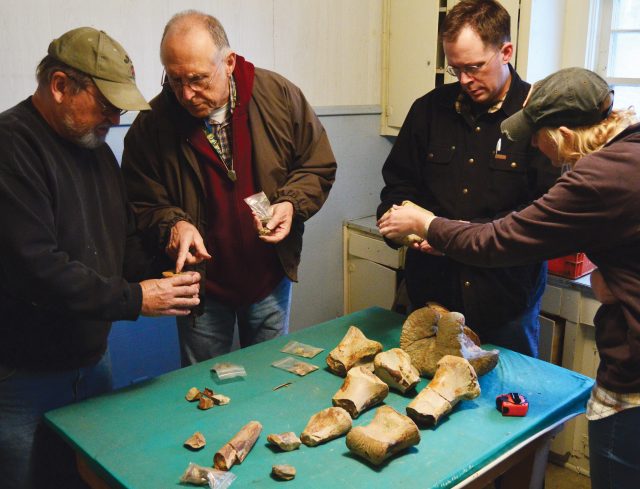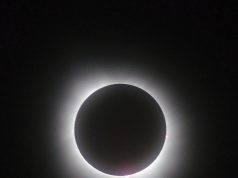
By John Balch
News-Leader staff
“I believe I know these bones,” said Dr. Carson Davis, a retired paleontologist with Southern Arkansas University.
Davis, along with SAU archaeologist Dr. Carl Drexler and student Fiona Taylor, was in Nashville last week at the Howard County EA Williams Chapel and Museum to inspect two milk-crates full of fossils that were said to be parts of a dinosaur dug up in Ben Lomond in 1985 and were recently donated to the museum.
Turns out Davis had indeed seen the bones back in the 1980s and he had brought along an authority on the matter – Jack Horner of Montana, described as one of the most prominent paleontologists in the United States and who served as technical advisor and even inspired a character in the Jurassic Park films.
In the 1970s, Horner, despite having no degree, discovered an extensive “nesting grounds” of a North American hadrosaur that contained fossilized dinosaur eggs and burrows. Horner is considered by his professional peers to be at the forefront of paleontological research, and in 2005 he found a piece of a Tyrannosaurus rex with soft tissue still intact.
Dr. Davis knew he had seen the bones, some of which are also believed to be that of a hadrosaur, the second he heard the story about how the bones had come to be in the museum’s possession.
The bones were donated to the Howard County museum by Charles Goodin, a former Nashville newspaper editor and former resident of Murfreesboro where his family operated the Miner’s Camping and Rock Shop just outside the Crater of Diamonds State Park. Goodin, who was born in 1987, said he had been told by his late father, Chuck, that the bones were dug up in Ben Lomond in September of 1985. Chuck was on his way home from Ashdown one day when he saw some people digging on the side of the road.
“Perpetually curious about what might be unearthed, he pulled over and discovered the bones shortly thereafter,” said Charles, who described his father as being “fascinated by rocks, minerals, fossils and any other geological oddities.”
Goodin said the bones were displayed in the family’s rock shop up until late last year when his mother Joyce was preparing for retirement. The Goodins wanted to find a home for the bones instead of relegating them storage.
“Not to get all Indiana Jones, but I felt very strongly that they should be in a museum,” Goodin told The Nashville News-Leader.
Dr. Davis told museum officials Freddie Horne and Susan Nanneman that around 1985 Horner had lectured at SAU and since he was “in this neck of the woods” he would take him to see the bones, which Chuck had apparently informed Davis about soon after the find. Davis said it was Horner who determined during a trip to the Murfreesboro rock shop that the bones were likely that of a hadrosaur, which is a prehistoric duck-billed species.
“I am glad to see they are being preserved,” said Davis, who noted the bones are very rare since only a few dinosaurs have been found in Arkansas.
As he handled and inspected the pile of fossils laid out on a table at the museum, Davis said the bones are very dense and very heavy for a reason. “You know you’re looking at something different when its that big with an articulating surface; it’s elephant-sized or maybe even bigger than an elephant.”
When the bones arrived at the museum, no one knew what to think, according to Horne, who is president of the Howard County Historical Society and oversees the museum. He and Nanneman were skeptical.
Nanneman said when she first heard about, but had not seen, the bones, she thought maybe they would turn out to be cow bones.
“You could run a steakhouse for a long time with one of these,” joked Dr. Drexler.
Also on hand last week was Allie Westbrook, who is an aspiring paleontologist at age 11. When Horne explained that the bones laid out on the table where actually dinosaur bones, the Nashville fifth-grader responded, “Awesome” and was allowed to touch and hold the fossils.
“They’re at least 65 millions years old,” Davis told Westbrook. “Cool,” she said with a wide-eyed look to her mom, Jenny.
The plan for the bones, now being stored in an undisclosed location, is now being worked out. Horne said he certainly wants them to be displayed, but how has yet to be determined.
“We want them, we want to protect them but we definitely want to show them,” Horne said. “We are privilege to have them, and apparently we are really lucky to have them.”
In the meantime, the bones will be photographed and documented and Dr. Davis has agreed to send the pictures to Horner to get his advice on the bones he inspected more than 30 years ago.
Goodin said that the museum seemed the obvious choice for a new home to the bones since they were found nearby. He also decided on the museum to honor the late Cecil Harris, who was Goodin’s colleague during his time at the newspaper.
“Cecil put forth a tremendous amount of effort to bring that museum to fruition, and I think he’d be extremely proud of the advances it’s made under Freddie’s leadership,” he said. “If this donation in any way helps them gain or maintain momentum, I consider that a fitting tribute and a win-win for both our families as well as the people of Howard County.”
Update on Arkansaurus
On the same day last week that the donated bones were inspected, Arkansas lawmakers voted unanimously to advance a proposal to make the Arkansaurus fridayi the state’s official dinosaur.
The proposal now moves to the full House for consideration.
The right hind foot bones of the dinosaur were discovered in 1972 by Joe B. Friday of Lockesburg on his Sevier County land. The bipedal beast, which likely stood 15 feet or more tall, currently represents the “only dinosaur bones found in Arkansas that have been brought to the attention of the scientific community,” according to Arkansas Geological Survey (AGS).







